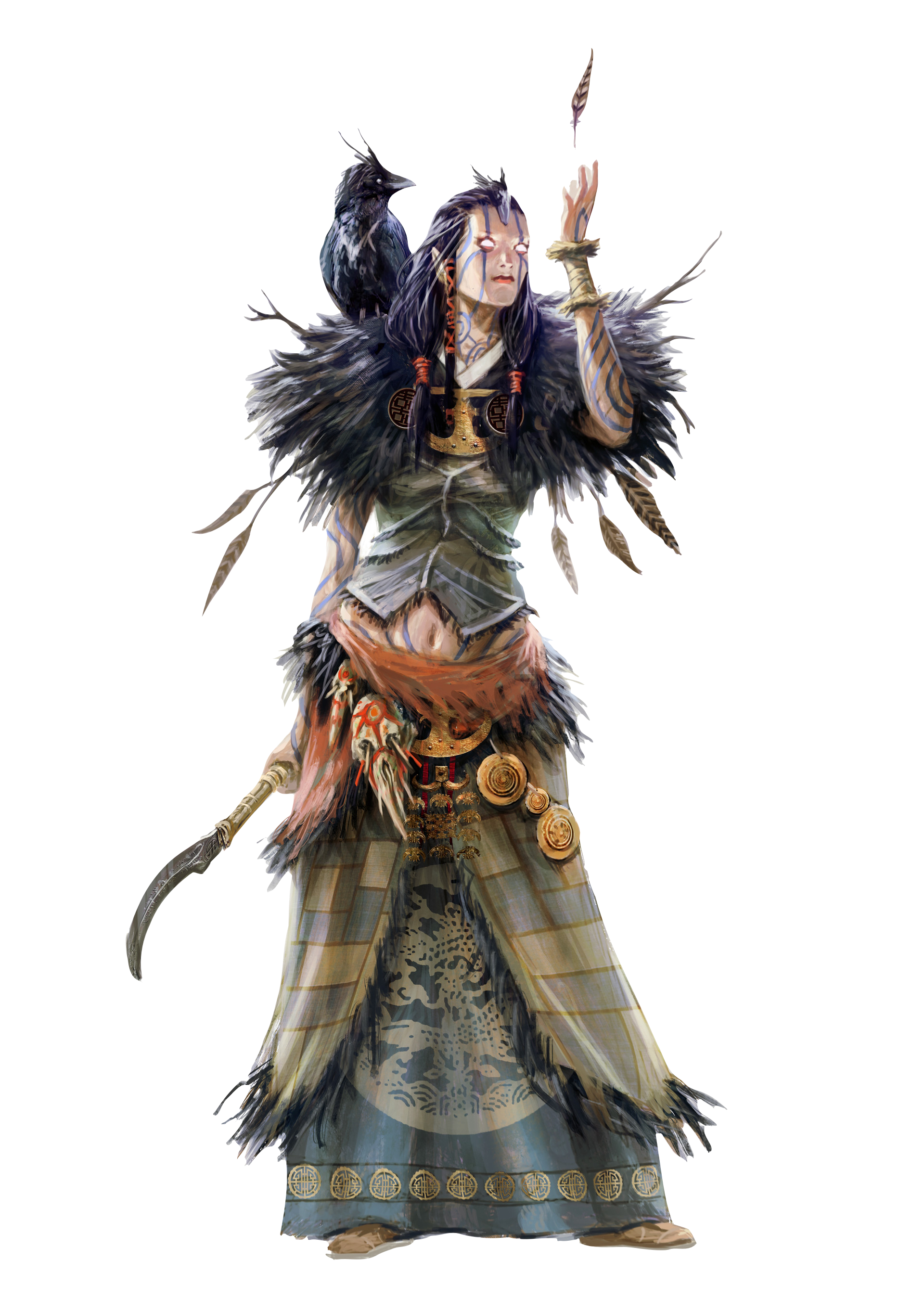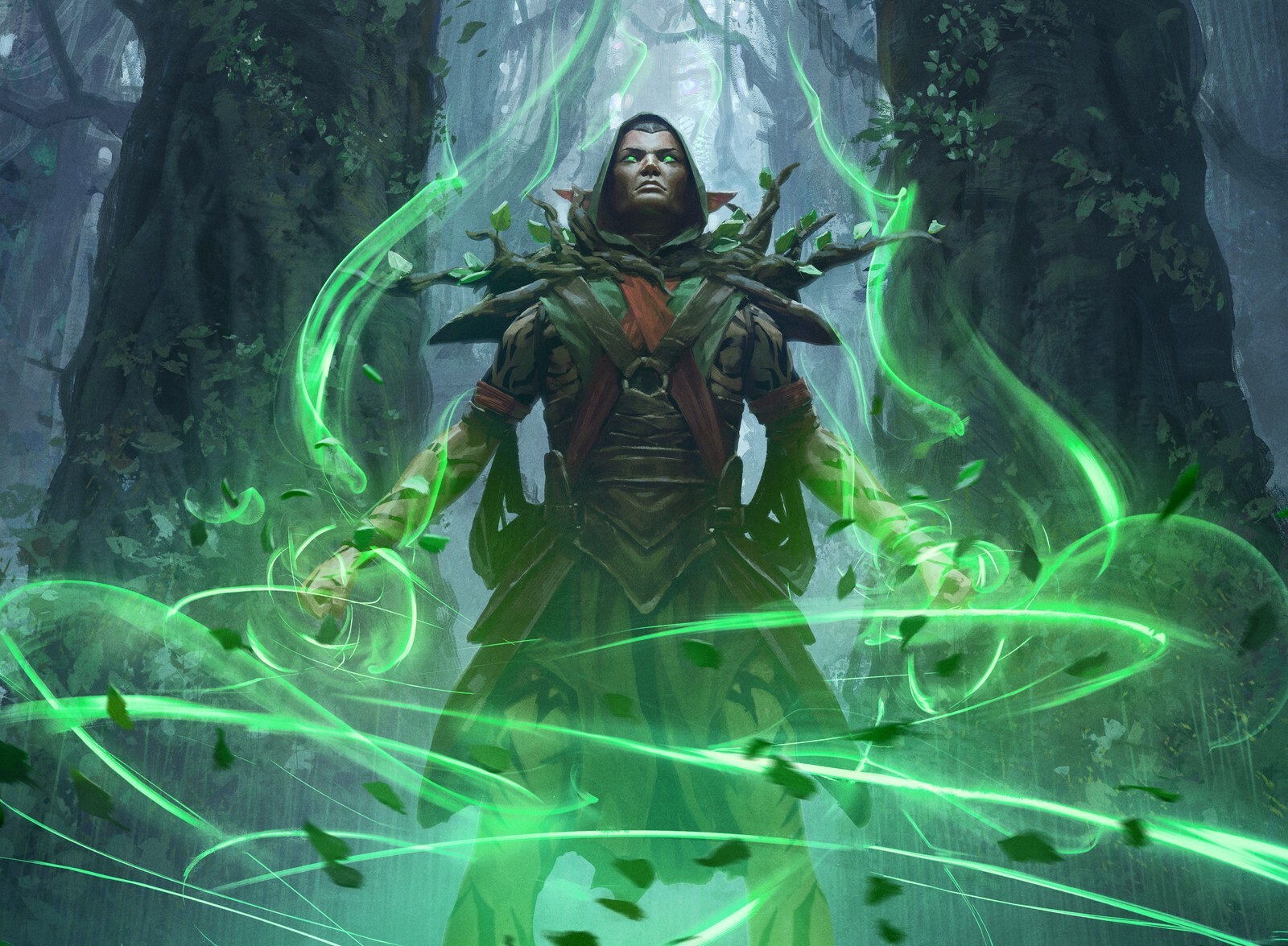
An old human walks along a woodland trail, deep in thought. Suddenly, bandits burst out from the forest, brandishing knives and crossbows and demanding his valuables. Without missing a beat, black bolts of energy form in the man's hands and he sends them at his assailants, instantly killing some of the bandits and sending the rest scrambling.
A dwarf stands in the burial grounds, a battleaxe in hand. The necromancer that has been raising the dead of his clan stands across from him, taunting him to attack. The dwarf whispers a quiet communion to his ancestors, and his weapon begins to glow with spiritual energy as he charges.
An elf crouches next to a dying man, the din of the battle around them drowned out by the words of power she speaks. She grasps the man's wrist, a soft green glow emanating from her hand. As the man's wounds close, the elf helps him to his feet. She gives a smile, and he returns it before heading back into the fray.
Shamans commune with the spirits and tap into mana, the name they give to the mystical energy of the soul.
Ancient Traditions
Shamanism, many believe, was among the first forms of magic. Long before the arcane studies of wizards and bards, before the natural sources of power that birthed sorcerers and led to warlocks, before the deific religions of clerics and paladins, there were two things: death and nature. Only druidism matches shamanism in age and mysticism.
The shamanic arts are old, ancient even, and the traditions surrounding its practice extend to the early days of intelligent humanoids. Spirit magic, old as it is, doesn't act the same way as other forms of magic; in fact, many have likened it to the magic that warlocks are granted by their patrons. Instead of casting spells, shamans get the majority of their magical capabilities from rites, spell-like powers that are fiercely-kept secrets of the shamanic tradition.
Shamanism also comes in many forms. No two shamans practice the art the same, but there are six predominant traditions, known as callings. They are known as: the Chieftain, the Guide, the Healer, the Oracle, the Voodooist, and the Witch. Each major calling uses the magic of the spirits in different ways, and each shamans has their own ends to which their power is applied.
Souls and Spirits
Mana—the energy of the soul, in shamanic cultures—is the source of spirit magic. Where mana comes from and why some entities have greater mana than others is one of the many secrets of shamanism. Some believe mana is directly tied to power; the more powerful an entity, be it in terms of physical might, magical power, or political influence, the more mana they have. Alternatively, some say mana is intertwined with one's destiny, and that those who are foretold to do great things in life have greater mana than those who fade into the background.
Either way, mana is the force that shamans manipulate for their magic. They usually draw it from the spirit realm itself, where the souls of the deceased and all of their mana goes when they die. More powerful shamans can draw mana out of living or recently departed souls, or even their own soul if they take care not to draw too much. Shamans are careful when using mana; it is a powerful and ancient force, and using it without care could end very poorly for the shaman.
Optional Rule: Multiclassing
If your group uses the optional rule on multiclassing in the Player's Handbook, here's what you need to know if you choose magus as one of your classes.
Ability Score Minimum. As a multiclass character, you must have at least a Wisdom score of 13 to take a level in this class, or to take a level in another class if you are already a shaman.
Proficiencies Gained. If shaman isn't your initial class, here are the proficiencies you gain when you take your first level as a magus: light armor, shields, and simple weapons.
Spell Slots. You can add the spell slots you gain from the Spirit Magic feature to your spell slots from any other source.




The Shaman
| Level | Proficiency Bonus | Features | Mana Points | Cantrips Known | Spell Slots | Slot Level | Rites Known |
|---|---|---|---|---|---|---|---|
| 1st | +2 | Spirit Magic, Medium | — | 3 | 1 | 1st | — |
| 2nd | +2 | Mana, Spiritual Rites | 2 | 3 | 2 | 1st | 2 |
| 3rd | +2 | Shamanic Calling | 3 | 3 | 2 | 2nd | 2 |
| 4th | +2 | Ability Score Improvement | 4 | 4 | 2 | 2nd | 2 |
| 5th | +3 | Medium | 5 | 4 | 2 | 3rd | 3 |
| 6th | +3 | Shamanic Calling feature | 6 | 4 | 2 | 3rd | 3 |
| 7th | +3 | Medium | 7 | 4 | 2 | 4th | 3 |
| 8th | +3 | Ability Score Improvement | 8 | 4 | 2 | 4th | 4 |
| 9th | +4 | Medium | 9 | 4 | 2 | 5th | 4 |
| 10th | +4 | Shamanic Calling feature | 10 | 5 | 2 | 5th | 4 |
| 11th | +4 | Spiritual Awakening (6th) | 11 | 5 | 3 | 5th | 5 |
| 12th | +4 | Ability Score Improvement | 12 | 5 | 3 | 5th | 5 |
| 13th | +5 | Spiritual Awakening (7th) | 13 | 5 | 3 | 5th | 5 |
| 14th | +5 | Shamanic Calling feature | 14 | 5 | 3 | 5th | 6 |
| 15th | +5 | Spiritual Awakening (8th) | 15 | 5 | 3 | 5th | 6 |
| 16th | +5 | Ability Score Improvement | 16 | 5 | 3 | 5th | 6 |
| 17th | +6 | Spiritual Awakening (9th) | 17 | 5 | 4 | 5th | 7 |
| 18th | +6 | Rite Weaving | 18 | 5 | 4 | 5th | 7 |
| 19th | +6 | Ability Score Improvement | 19 | 5 | 4 | 5th | 7 |
| 20th | +6 | Soul Drain | 20 | 5 | 4 | 5th | 8 |
Class Features
As a shaman, you gain the following class features.
Hit Points
- Hit Dice: 1d8 per shaman level
- Hit Points at 1st Level: 8 + your Constitution modifier
- Hit Points at Higher Levels: 1d8 (or 5) + your Constitution modifier per shaman level after 1st
Proficiencies
- Armor: Light armor, medium armor, shields
- Weapons: Simple weapons
- Tools: None
- Saving Throws: Wisdom, Charisma
- Skills: Choose two from Nature, Insight, Animal Handling, Perception, Survival, Medicine, and Religion
Equipment
You start with the following equipment, in addition to the equipment granted by your background:
- (a) a simple weapon and a shield or (b) two simple weapons
- (a) a quarterstaff or (b) any simple weapon
- (a) an explorer's pack or (b) a priest's pack
- hide armor and a shamanic totem
Spirit Magic
You can commune with the spirits to cast shaman spells.
Cantrips Known
At 1st level, you know three cantrips of your choice from the shaman spell list. You learn additional shaman cantrips of your choice at higher levels, as shown in the Cantrips Known column of the Shaman table.
Preparing and Casting Spells
The Shaman table shows how many spell slots you have. The table also shows what level those slots are; all of your spell slots are the same level. To cast one of your shaman spells of 1st level or higher, you must expend a spell slot. You regain all expended spell slots when you finish a short or long rest.
You prepare the list of shaman spells that are available for you to cast, choosing from the shaman spell list. When you do so, choose a number of shaman spells equal to your Wisdom modifier + your half shaman level, rounded up (minimum of one spell). A spell you choose must be of a level no higher than what's shown in the table's Slot Level column for your level.

You can change your list of prepared spells when you finish a short or long rest. Preparing a new list of shaman spells requires time spent communing with the spirits.
Spellcasting Ability
Wisdom is your spellcasting ability for your shaman spells, as your spells come from your abilitiy to contact the spirits. You use your Wisdom whenever a shaman spell refers to your spellcasting ability. In addition, you use your Wisdom modifier when setting the saving throw DC for a shaman spell you cast and when making an attack roll with one.
Spell Save DC = 8 + your proficiency bonus + your Wisdom modifier
Spell Attack Modifier = Your proficiency bonus + your Wisdom modifier
Ritual Casting
You can cast a shaman spell as a ritual if that spell has the ritual tag and you have the spell prepared. It is cast at its lowest level.
Spellcasting Focus
You can use a shamanic totem as a spellcasting focus for your shaman spells.
Medium
Shamans are intermediaries of the spirits, and are favored by them. You have advantage on Charisma checks made to interact with intelligent spirits, such as ghosts.
Once you reach 5th level, you become resistant to necrotic damage. At 7th level, your hit point maximum can no longer be reduced. Finally, starting at 9th level, for every 10 years that pass, your body ages only 1 year.
Mana
Starting at 2nd level, you learn how to manipulate life force, which shamans call mana. Your ability to manipulate this force is represented by a number of mana points. Your shaman level determines the number of points you have, as shown in the Mana Points column of the Shaman table.
You can use your mana points to fuel rites. You start knowing 2 rites, as described by your Spiritual Rites feature.
When you spend a mana point, it is unavailable until you finish a short or long rest, at which point realign yourself with the mana of other creatures and regain all of your expended mana points.
Spiritual Rites
Also at 2nd level, you can perform spiritual incantations called rites. You learn two spiritual rites of your choice from the options listed at the end of the class description. When you gain certain shaman levels, you gain additional rites of your choice, as shown in the Rites Known column of the Shaman table.
When you gain a level in this class, you can choose one of the rites you know and replace it with another rite that you could learn at that level.
A level prerequisite in a rite refers to your shaman level, not your character level. If a rite requires you to make a spell attack or requires your target to make a saving throw, you use your shaman spell attack modifier and spell save DC.
Shamanic Calling
At 3rd level, a specific form of shamanic magic begins to call to you. Choose from the Calling of the Chieftain, the Calling of the Guide, the Calling of the Healer, the Calling of the Oracle, the Calling of the Voodooist, or the Calling of the Witch, each detailed at the end of the class description. Your choice grants you features at 3rd level and again at 6th, 10th, and 14th level.
Ability Score Improvement
When you reach 4th level, and again at 8th, 12th, 16th, and 19th level, you can increase one ability score of your choice by 2, or you can increase two ability scores of your choice by 1. As normal, you can't increase an ability score above 20 using this feature.
Spiritual Awakening
At 11th level, you become awakened to true spiritual power. When you finish a long rest, choose one 6th-level spell from the shaman spell list as your awakening.
You can cast your awakening spell once without expending a spell slot. You must finish a long rest before you can do so again.
At higher levels, you can choose more shaman spells that can be cast in this way: a 7th-level spell at 13th level, a 8th-level spell at 15th level, and a 9th-level spell at 17th level. You can choose which spells are prepared in each slot at the end of a long rest. You regain all uses of your Spiritual Awakening when you finish a long rest.
Rite Weaving
At 18th level, you can readily learn new rites. When you finish a long rest, you can choose one spiritual rite you know and replace it with another rite you meet the prerequisites for.
Soul Drain
At 20th level, you are a master of converting death into life, and life into death. When a creature within 30 feet of you dies, you can use your reaction to drain part of their soul to regain 1 expended mana point.
Additionally, as an action, you can drain your own soul to regain up to 5 expended mana points. For each mana point regained using this action, your hit point maximum is reduced by 15 points. This reduction lasts until you finish your next long rest, and cannot be prevented or reduced, even by your Medium feature. Once you use this action, you can't use it again until you finish a long rest.
Shamanic Callings
Shamanic magic comes in many forms and can be used in many different ways. Each discipline of shamanism is called a Calling; this is due to the fact that it is not always the shaman themselves that decides how they use the magic granted by the spirits, but rather, the spirits decide. The shaman merely feels "called" to a certain spiritual form of magic. Some shamans do consciously practice the teachings of different callings, but for others it is more of a natural power given to them by the spirits and that they have no more control over than the spirits themselves.

Calling of the Chieftain
In shamanic culture, chieftains are leaders and fighters. They often commune with the spirits of ancient warriors, and bring the battle experience of a thousand generations before them to bear in each and every fight.
Calling of the Chieftain Features
| Level | Features |
|---|---|
| 3rd | Chieftain's Training, Spirit Strike |
| 6th | Extra Attack |
| 10th | Ancestral Chant |
| 14th | Army of a Thousand Fallen |
Chieftain's Training
When you choose this calling at 3rd level, you have been trained to fight by the spirits you commune with. You gain proficiency with martial weapons. Additionally, your hit point maximum increases by 3, and increases by 1 whenever you gain a level in this class.
Spirit Strike
Also at 3rd level, you gain the ability to infuse your strikes with spiritual energy. This feature counts as a spiritual rite, but it doesn't count against the number of rites you know, and you cannot replace it.
As an action, you can spend a number of mana points up to your proficiency bonus and make a weapon attack with one weapon you are currently holding. This weapon attack gains a bonus to the attack roll equal to number of mana points spent. If the attack hits, it deals 1d4 additional necrotic damage for each mana point spent, and the target's hit point maximum is reduced by the necrotic damage taken for 1 minute.
Extra Attack
At 6th level, you can attack twice, instead of once, whenever you take the Attack action on your turn. You can use your Spirit Strike rite in place of one of these attacks if you so choose.
Ancestral Chant
At 10th level, you can invoke bolstering spirit magic with a chant as you fight. When you use your Spirit Strike rite, you also gain a pool of temporary hit points equal to twice the amount of necrotic damage the target takes. You can divide these temporary hit points among any creatures of your choice within 30 feet of you that can hear you, including possibly yourself.
Army of a Thousand Fallen
At 14th level, you can call upon the spirits of fallen warriors to briefly aid you in combat. As an action, you can call upon an army of spirits for 1 minute. The army appears in a 30-foot radius around you for the duration, and moves with you. The army is incorporeal and takes up no space.
When you call upon the army, it takes a formtion of your choice from the options listed below. As a bonus action on your turn while the army is active, you can change the army's formation.
Phalanx. The spirits take a defensive position around all your allies. All attacks against allied creatures within the radius have disadvantage. Additionally, if a creature makes an attack against an ally within the radius, and it is also within the radius, it takes 2d8 necrotic damage.
Vanguard. The spirits take an offensive position in the area around you. All hostile creatures who start their turn in the radius take 2d8 necrotic damage. Additionally, all attacks against hostile creatures within the radius have advantage.
Once you use this feature, you can't use it again until you finish a long rest.


Calling of the Guide
Guides are shamans that have a close connection with the spirits, a connection that more allows them to summon the souls of the dead to the realm of the living more readily and more often than other shamans.
Calling of the Guide Features
| Level | Features |
|---|---|
| 3rd | Guardian Spirit, Spirit Swarm |
| 6th | Essence Bond |
| 10th | Unfettered Souls |
| 14th | Lethal Spirit |
Guardian Spirit
When you choose this calling at 3rd level, a guardian spirit follows you at all times. It is friendly to you and your companions, and obeys your commands. See its game statistics in the Guardian Spirit stat block, which uses your proficiency bonus (PB) in several places.
In combat, the spirit shares your initiative count, but it takes its turn immediately after yours. It can move and use its reaction on its own, but the only action it takes on its turn is the Dodge action, unless you take a bonus action on your turn to command it to take another action. That action can be one in its stat block or some other action. If you are incapacitated, the spirit can take any action of its choice, not just Dodge.
If the spare the dying spell is cast on it, it regains 2d6 hit points. If it dies, it disappears, and you can resummon it by spending 2 mana points over the course of a minute. At the end of the minute, it reappears with all its hit points restored.
At the end of a long rest, you can resummon the spirit or summon a new spirit without expending mana points. If you already have a spirit from this feature, the first one immediately disappears. It also disappears if you die.
Spirit Swarm
Also at 3rd level, you gain the ability to summon a swarm of lesser spirits. This feature counts as a spiritual rite, but it doesn't count against the number of rites you know, and you cannot replace it.
As an action, you can spend a number of mana points up to your proficiency bonus to manifest 2 spirits for each mana point spent. They hover around you in your space. While these spirits surround you, you gain the following benefits.
- When you take damage, you can dismiss one of the spirits as a reaction to halve the attack's damage against you, as you have the spirit absorb some of the attack's damage.
- When you deal damage with a weapon, spell, or rite, you can dismiss one of the spirits to deal additional damage equal to your Wisdom modifier, as you imbue the attack with the spirit's energy.
This rite ends when all of the spirits are dismissed, after 10 minutes, or until you use this rite again.
Essence Bond
At 6th level, you have formed a spiritual bond with your guardian spirit. If both you and the spirit are within 5 feet of a creature and both of you aren't incapacitated, you both have advantage on attack rolls against that creature.
Additionally, the spirit can use its Renew Soul action on you if you are within 5 feet of it.
Unfettered Souls
At 10th level, you can summon your spirit swarm around others. When you use your Spirit Swarm rite, instead of gaining the benefits yourself, you can choose a creature within 30 feet of you to gain the benefits of the rite, using your Wisdom modifier where needed.
Lethal Spirit
At 14th level, your guardian spirit becomes more powerful, and thus, more deadly. It gains the following benefits.
- The damage of the spirit's Rend Soul increases to 1d10 + PB necrotic damage.
- The hit points restored by the spirit's Renew Soul increases to 5d4 + PB.
- Whenever the spirit uses its Vex, the attacker takes necrotic damage equal to 1d4 + your Wisdom modifier.
Guardian Spirit
Medium undead
- Armor Class 15 (natural armor)
- Hit Points 2 + your Wisdom modifier + 5 times your shaman level (the spirit has a number of Hit Dice [d8s] equal to your shaman level)
- Speed 30ft., fly 10ft.
STR DEX CON INT WIS CHA 8 (-1) 12 (+1) 14 (+2) 10 (0) 14 (+2) 6 (-2)
- Saving Throws Con +2 plus PB
- Skills Perception +2 plus PB, Intimidation -2 plus PB
- Damage Immunities poison
- Damage Resistances necrotic
- Condition Immunities exhaustion, frightened, poisoned
- Senses darkvision 60 ft., passive Perception 12 plus PB
- Languages Common
- Challenge —
- Proficiency Bonus (PB) equals your bonus
Foresight. The spirit can't be surprised.
Actions
Rend Soul. Melee Weapon Attack: your spell attack modifier to hit, reach 5 ft., one target you can see. Hit: 1d8 + PB necrotic damage.
Renew Soul (3/day). The spirit mends itself, regaining 4d4 + PB hit points.
Reactions
Vex. The spirit imposes disadvantage on the attack roll of one creature it can see that is within 5 feet of it, provided the attack roll is against a creature other than the spirit.

Calling of the Healer
Spirit magic is more than capable of mending the soul, and healers are shamans that use this capability to its fullest. There is no ailment they cannot cure, no wound they cannot close, and if worse comes to worst, they can bring the soul back to the body with ease.
Calling of the Healer Features
| Level | Features |
|---|---|
| 3rd | Spirit Mark, Soulmending |
| 6th | Healer's Remedy |
| 10th | Dualistic Mark |
| 14th | Soul Link |
Spirit Mark
When you choose this calling at 3rd level, you gain the ability to mark a creature's soul to greater heal them. This feature counts as a spiritual rite, but it doesn't count against the number of rites you know, and you cannot replace it.
As a bonus action, you can spend a number of mana points up to half your proficiency bonus (rounded down) and manifest a spirit mark on a creature of your choice within 30 feet of you. The mark lasts for 1 minute, until you end it early as a bonus action, or until you use this rite again.
When you roll dice to restore hit points to a creature with your spirit mark, you roll 1 additional die for each mana point spent. Only the creature with the mark benefits from this additional healing.
Soulmending
Also at 3rd level, you have a reserve of restorative magic. You have a number of d6's, called soulmending dice, equal to half your shaman level (rounded up).
As an action, you can choose a creature within 60 feet of you and spend a number of soulmending dice up to half your maximum (rounded down). Roll the spent dice and add them together. The target regains a number of hit points equal to the total + your Wisdom modifier.
You regain all expended soulmending dice when you finish a long rest.
Healer's Remedy
At 6th level, you can start to cure serious ailments. You have a number of uses of this feature equal to your proficiency bonus. As an action, you can expend a use of this feature and touch a creature. You can choose to cure one disease or neutralize one poison affecting the target, or you can end one effect on them that is giving them one of the following conditions: blinded, charmed deafened, frightened, paralyzed, poisoned, or stunned.
You can expend multiple uses at once, curing one disease, neutralizing one poison, or ending one of the listed conditions for each use expended. As part of the action you use to use this feature, you can spend soulmending dice to not expend uses of this feature; one use for each die spent.
You regain all expended uses of this feature when you finish a long rest.
Dualistic Mark
At 10th level, you can manifest more than one spirit mark. When you use your Spirit Mark rite, you can use it again on a second creature without the first mark immediately ending. If you attempt to create a third mark, the oldest mark ends. A creature can only benefit from one mark at a time.
Soul Link
At 14th level, you can tether the souls of two creatures together. As an action, you can choose two allied creatures that are both within 30 feet of you and within 30 feet of each other. For the next minute, when one of those creatures regains hit points, the other creature regains the same amount of hit points.
Additionally, when one of the creatures takes damage, the other creature can use their reaction to prevent half the damage. They then take damage equal to the amount they prevented.
This effect ends if they are ever more than 30 feet away from each other. Once you use this feature, you can't use it again until you finish a long rest.


Calling of the Oracle
The spirits are wise. These dead souls, who lived full lives in ages past and who persist, watching the living world idly, have much wisdom and knowledge to share with shamans, or oracles, as they were, who seek their advice and guidance.
Calling of the Oracle Features
| Level | Features |
|---|---|
| 3rd | Spirit Omen, Spiritual Guidance |
| 6th | Vision Quest (clairvoyance) |
| 10th | Auspices |
| 14th | Prophetic Lore, Vision Quest (scrying) |
Spirit Omen
When you choose this calling at 3rd level, you gain the ability to read omens from the spirits. This feature counts as a spiritual rite, but it doesn't count against the number of rites you know, and you cannot replace it.
As a reaction when you or another creature within 30 feet of you makes an attack roll, ability check, or saving throw, you can spend a number of mana points up to half your proficiency bonus (rounded up). When you do so, roll a number of d4's equal to the number of mana points spent. The total rolled is then added to or subtraced from (your choice) the triggering roll.
Spiritual Guidance
Also at 3rd level, the spirits begin to guide you in everyday life. Whenever you finish a short or long rest, you can gain one skill or tool proficiency of your choice. You lose this proficiency when you use this feature to choose a different proficiency that you lack.
Vision Quest
At 6th level, you can see visions while you rest. When you finish a long rest, you can cast the clairvoyance spell without expending a spell slot and without material components.
When you reach 14th level in this class, you can instead cast the scrying spell in this manner.
Auspices
At 10th level, the omens you read are increasingly tipped in your favor. When you use your Spirit Omen rite, you can reroll one of the dice once. You must use the new roll.
Prophetic Lore
At 14th level, you can learn a great deal of knowledge about the future by asking the spirits for it. Over the course of a minute, you can perform a ritual and learn one of the following pieces of information of your choice.
- The exact location of a creature or group of creatures that you specify, regardless of the plane you or they are on.
- The specific repercussions of an action or event that will or might take place within the next year or that has occurred5 within the last 100 years.
- The answer to one question not listed, such as: "Why did the king declare war with the elves?" If the question cannot be answered factually, then you hear no answer.
Once you use this feature, you can't use it again for 7 days.


Calling of the Voodooist
Mana is a powerful force. This raw energy of the soul powers all shamanic magic. Voodooists, however, seek to make the most of mana's incredible power. They admire the potential that is has, and want to unleash and utilize it to its fullest.
Calling of the Voodooist Features
| Level | Features |
|---|---|
| 3rd | Spirit Focus, Surge of Mana |
| 6th | Voodoocraft |
| 10th | Focused Voodoo |
| 14th | Spiritual Contemplation |
Spirit Focus
When you choose this calling at 3rd level, you gain the ability to channel large amounts of magic at once. This feature counts as a spiritual rite, but it doesn't count against the number of rites you know, and you cannot replace it.
Immediately after you use an action or bonus action on your turn, you can use this rite to cast a shaman spell with a casting time of 1 action as a free action. If you do so, you must spend mana points equal to the level of the spell (1 point for a cantrip). Alternatively, you can choose to use a rite that takes 1 action to use, in which case you must spend mana points equal to half the amount of mana points you spend for the rite (rounded up).
You can only use this rite once a round.
Surge of Mana
Also at 3rd level, you can use mana to wield your spirit magic, and use your spirit magic to recover mana.
Mana Surge. As a bonus action, you can expend one shaman spell slot and gain a number of mana points equal to the slot's level.
Spell Surge. As a bonus action, you can expend mana points to create a spell slot. The Spell Surge Conversion table shows the cost of creating a spell slot of a given level. The created spell slots vanish when you finish a short or long rest. They count as shaman spell slots for you.
These slots can be of any level, not just the level shown in the Slot Level column of the Shaman table. To cast a spell using these slots, you must expend a slot of the spell's level or higher.
Spell Surge Conversion
| Spell Slot Level | Mana Point Cost |
|---|---|
| 1st | 2 |
| 2nd | 3 |
| 3rd | 5 |
| 4th | 6 |
| 5th | 7 |
Voodoocraft
At 6th level, you can empower your spiritual magic through concentration. When you expend a spell slot to cast a spell of 1st level or higher as an action, you can choose to gather power for it. When you do so, you do not cast the spell, and instead must concentrate on it until you use your action on your next turn to cast the spell. When you do this, the spell is cast as though you had expended a spell slot of one level higher to cast it.
Alternatively, you can use this feature when you use a rite as an action. You must concentrate on the rite (as if you were concentrating on a spell) until you use your action on your next turn to use the rite. When you do this, the rite acts as though you had spent 1 additional mana point to use it.
You have a number of uses of this feature equal to half your proficiency bonus (rounded down), and regain all expended uses when you finish a long rest.
Focused Voodoo
At 10th level, you can channel more powerful amounts of spiritual magic. When you use your Spirit Focus rite to cast a spell of 1st-level or higher or to use a rite, you can use your Voodoocraft feature on the spell or rite.
Spiritual Contemplation
At 14th level, you can focus on multiple magical effects at once. You can now concentrate on two spells or abilities that require you to concentrate. However, while you concentrate on two such effects simultaeneously, you can't take reactions, you have disadvantage on all saving throws except to maintain concentration, and all attacks against you have advantage.
Additionally, when you are concentrating on two effects and your concentration on either effect is broken, you must make a DC 15 Wisdom saving throw. On a failure, you are stunned until the end of your next turn.


Calling of the Witch
Shamanism has a dark side, and witches tap into this power. They use spiritual magic to curse, cripple, and kill their opponents. Among shamans, they are generally reviled for their perceived perversion of the spirit's will.
Calling of the Witch Features
| Level | Features |
|---|---|
| 3rd | Spirit Hex, Black Magic |
| 6th | Unto The Grave |
| 10th | Scourge |
| 14th | Witch's Eye |
Spirit Hex
When you choose this calling at 3rd level, you gain the ability to curse your targets. This feature counts as a spiritual rite, but it doesn't count against the number of rites you know, and you cannot replace it.
As an action, you can spend 2 mana points and choose a creature within 30 feet of you. The chosen creature must make a Wisdom saving throw. On a failure, it is cursed, suffers one of the following effects of your choice for the next minute. At the end of each of its turns, it can remake the saving throw, ending the effect on a success. This effect immediately ends if you use this rite again.
- Hex of Weakness. The creature suffers a penalty to Strength saving throws and attack rolls using Strength equal to the number of mana points spent.
- Hex of Lethargy. The creature suffers a penalty to Dexterity saving throws equal to the number of mana points spent. It also has its speed reduced by an amount of feet equal to 5 x the number of mana points spent.
- Hex of Pain. The creature suffers a penalty to Constitution saving throws equal to the number of mana points spent. It also takes additional necrotic damage equal to the number of mana points spent when it takes damage; this damage can only be dealt once per round.
- Hex of Foolishness. The creature suffers a penalty to Wisdom saving throws and ability checks equal to the number of mana points spent.
- Hex of Stupidity. The creature suffers a penalty to Intelligence saving throws equal to the number of mana points spent. It also has its spell save DCs and spell attack rolls reduced by an amount equal to the number of mana points spent.
- Hex of Revulsion. The creature suffers a penalty to Charisma saving throws and ability checks equal to the number of mana points spent.
When you use this rite, you can spend additional mana points. The maximum number of mana points you can spend for this rite, including the first two mana points, is equal to your proficiency bonus.
Black Magic
Also at 3rd level, you can use your magic to harm other creatures. Once per round when you deal damage to another creature with a shaman spell or rite, you can deal additional necrotic damage to the creature equal to your proficiency bonus.
Unto The Grave
At 6th level, your dark magic is more lethal than most. When you roll one or more dice to deal necrotic damage to a creature, you can choose to instead use the highest number possible for each die.
You can use this feature a number of times equal to your proficiency bonus, and regain all expended uses when you finish a long rest.
Scourge
At 10th level, you can curse creatures for longer periods of time. When you use your Spirit Hex rite, instead of increasing the penalty, you can spend mana points to increase the duration. For each mana point spent in this way, the rite's duration increases by one time increment, starting at 1 minute and increasing to 10 minutes, then 1 hour, then 8 hours, then 1 day, then 1 week. You can still only spend mana points for this rite up to your proficiency bonus, and you must spend at least 1 mana point to increase the penalty.
For example, if you spend 4 mana points to use Spirit Hex, you can grant the target a -4 penalty for 1 minute, a -3 penalty for 10 minutes, a -2 penalty for 1 hour, or a -1 penalty for 8 hours.
Witch's Eye
At 14th level, you can use your supernatural gaze to peer at those who carry your curse. You know the distance and direction to creatures you have cursed with a spell or feature if they are on the same plane as you, and creatures you have cursed don't gain the benefits of being hidden from you.


Spiritual Rites
Essence Bolt
As an action, you can spend a number of mana points up to your proficiency bonus to make a ranged spell attack against one creature within 60 feet of you. On a hit, the creature takes 1d4 necrotic damage, plus an additional 1d4 necrotic damage for each mana point spent. This damage cannot be reduced in any way, as it harms the soul and not the body. It does not ignore immunity.
Ethereal Armor
As a bonus action, you can spend 1 mana point to don a spiritual set of armor. Your base AC then becomes 13 + your Wisdom modifier for 1 hour. You can wield a shield and still gain this benefit.
Exhilarate
As a bonus action, you can touch a creature and spend a number of mana points up to your proficiency bonus. For each mana point spent, the target gains 5 temporary hit points. These temporary hit points fade after 1 hour.
Familiar Spirit
As an action, you can spend 1 mana point to cast the find familiar spell without expending a spell slot. When you cast find familiar in this way, the familiar is an undead instead of a beast. This version of the spell conjures a ghostly familiar.
Horrifying Visage
As an action, you can spend 2 mana points to summon the visage of a spirit in an unoccupied space within 30 feet of you. Each creature of your choice within 10 feet of the visage that can see it must make a Wisdom saving throw. On a failure, a creature is frightened until the end of your next turn. The visage then disappears.
When you use this rite, you can spend additional mana points, increasing the radius of the aura by 5 feet for each mana point spent beyond the first two. The maximum number of mana points you can spend for this rite, including the first two mana points, is equal to your proficiency bonus.
Rejuvenate
As an action, you can spend a number of mana points up to your proficiency bonus and touch a creature. For each mana point spent, the target regains 1d8 hit points.
Shamanic Ceremony
When you cast a shaman spell of 1st-level or higher, you can spend mana points equal to twice the spell's level instead of expending a spell slot to cast the spell as a ritual (even if you normally aren't able to). The spell is cast at its lowest level.
The maximum amount of mana points you can spend for this rite is equal to half your shaman level, rounded up (minimum of 2 mana points).
Soulsight
As a bonus action, you can spend 1 mana point to open your awareness to souls and peer into the spirit realm. Until the start of your next turn, you know the distance direction to all creatures that have a soul within 60 feet of you, and you can see into the Ethereal Plane out to the same range for the duration.
Spear of the Elders
As a bonus action, you can spend 1 mana point and bind spiritual energy to one weapon of your choice that you are holding. For the next 8 hours, you can use your Wisdom, instead of Strength or Dexterity, for the attack and damage rolls of that weapon.
You can spend 1 additional mana point to grant this benefit to a second weapon you are holding.
Spiritual Ward
As an action, you can spend 2 mana points to manifest a spiritual ward within 30 feet of you. The war lasts for 1 minute. When an allied creature takes damage while within 10 feet of the ward, the damage they take is reduced by 5.
When you use this rite, you can spend additional mana points, increasing the damage prevented by 5 for every 2 mana points spent beyond the first two. The maximum number of mana points you can spend for this rite, including the first two mana points, is equal to your proficiency bonus.
Undying Presence
As an action, you can spend 2 mana points, and for the next minute, creatures of your choice within 10 feet of you have advantage on death saving throws, and do not suffer an additional unsuccessful death save from critical hits. This rite ends early if you are incapacitated or die.
Wail of the Dead
As an action, you can spend 2 mana points to let out a wail of pain and anguish. Every creature within 15 feet of you that can hear you must make a Wisdom saving throw. On a failed save, a target takes 1d6 necrotic damage.
When you use this rite, you can spend additional mana points, increasing the necrotic damage dealt by 1d6 for each mana point spent beyond the first two. The maximum number of mana points you can spend for this rite, including the first two mana points, is equal to your proficiency bonus.
Bind Soul
Prerequisite: 5th level
As a reaction when a creature you can see dies within 30 feet of you, you can spend 1 mana point to bind its soul to a Tiny object you are holding or that is on your person.
As an action, you can release a spirit bound in this way by touching the object it is bound to. Doing so allows you to ask the spirit one question, which it answers in a language it knew in life. You hear its answer in your mind. It is in no way obligated to answer directly, though it may not knowingly lie to you.
Death Plague
Prerequisite: 5th level
As an action, you can spend 3 mana points and force one creature of your choice within 30 feet of you to make a Constitution saving throw. On a failure, it is afflicted with a death plague for 1 minute. At the start of each of the target's turn while it is afflicted, it takes 1d6 necrotic damage.
When you use this rite, you can spend additional mana points, increasing the necrotic damage dealt by 1d6 for each mana point spent beyond the first three. The maximum number of mana points you can spend for this rite, including the first three mana points, is equal to your proficiency bonus.

Ghost Step
Prerequisite: 5th level
As a bonus action, you can spend a number of mana points up to your proficiency bonus. You then step through the spirit realm, teleporting to an unoccupied space within a number of feet equal to 10 x the number of mana points you spent.
Rouse the Soul
Prerequisite: 5th level
As an action, you can spend 5 mana points and touch a creature that has died within the last 10 minutes. If it is willing and able, it returns to life with 1 hit point. This spell can’t return to life a creature that has died of old age, nor can it restore any missing body parts.
Sever Soul
Prerequisite: 5th level
As an action, you can spend 2 mana points and force one creature of your choice within 30 feet of you to make a Constitution saving throw. On a failure, that creature's soul is severed from their body for a moment, and they become paralyzed until the end of your next turn.
When you use this rite, you can spend additional mana points, increasing the number of creatures you can target by 1 for every 2 mana points spent beyond the first two. The maximum number of mana points you can spend for this rite, including the first two mana points, is equal to your proficiency bonus.
Vitiate
Prerequisite: 5th level
As an action, you can spend 3 mana points and force one creature of your choice within 30 feet of you to make a Constitution saving throw. On a failure, that creature suffers one level of exhaustion. This rite cannot be used to increase a creature's exhaustion level beyond level 5.
When you use this rite, you can spend 3 additional mana points to increase the levels of exhaustion suffered by 1. The maximum number of mana points you can spend for this rite, including the first three mana points, is equal to your proficiency bonus.
Call Spirit
Prerequisite: 14th level
Over the course of 10 minutes, you can spend 4 mana points and name one spirit of your choice. You can be as specific or as vague as you wish when naming a spirit, such as "a spirit from the city of Vasselheim" or "the spirit of my grandfather Wilfred." The DM ultimately determines what spirit you contact.
You may ask the spirit up to 5 questions over the course of the following 10 minutes, which it can answer with all of the knowledge it had in life and has in death. The both of you understand each other, even if you normally would not be able to. It is in no way obligated to answer directly, though it may not knowingly lie to you.
Haunt
Prerequisite: 14th level
As an action, you can spend 10 mana points to choose a creature you can see within 30 feet of you. That creature must make a Charisma saving throw or become possessed
by a spirit under your control.
On a failed save, the target creature becomes incapacitated and loses control of its body. While the target is possessed, you can issue commands to it (no action required), which it must obey to the best of its ability. You can use your action to take precise control of the target. Until the end of your next turn, the creature takes only the actions you choose, and doesn’t do anything that you don’t allow it to do. During this time, you can also cause the creature to use a reaction, but this requires you to use your own reaction as well.
This effect ends if the target is reduced to 0 hit points, has the dispel evil and good or remove curse spell cast on them, if you use this rite again, or after 1 minute. The target is immune to this rite for 24 hours after succeeding the saving throw or after this effect ends.
Incorporeality
Prerequisite: 14th level
As a bonus action, you can spend 5 mana points become incorporeal for 10 minutes. While incorporeal, you are immune to all damage and conditions, and can move through objects, surfaces, and creatures. You also gain a flying speed of 15 feet, which you can use to hover.
This effect immediately ends if you make an attack, cast a spell, or use a rite.
Revitalize
Prerequisite: 14th level
As an action, you can spend 5 mana points and touch a creature. The target is then revitalized for 1 minute, and regains 1d8 hit points at the start of each of its turns for the duration.
This effect immediately ends if you use this rite again.
Spiritual Journey
Prerequisite: 14th level
As an action, you can spend 8 mana points to cast the teleport spell. When you cast the teleport spell in this way, you cannot target an object; you must target creatures. This version of the spell pulls a creature's spirit out of its body and shunts it through the spirit realm to the chosen destination, where the body reforms.


Cantrips (0 Level)
- Chill Touch
- Guidance
- Light
- Magic Stone
- Mending
- Resistance
- Sapping Sting
- Spare the Dying
- Thaumaturgy
- Toll the Dead
- True Strike
1st Level
- Arms of Hadar
- Bane
- Bless
- Cause Fear
- Ceremony
- Command
- Comprehend Languages
- Cure Wounds
- Detect Evil and Good
- Detect Magic
- Detect Poison and Disease
- False Life
- Healing Word
- Hex
- Identify
- Inflict Wounds
- Protection from Evil and Good
- Purify Food and Drink
- Ray of Sickness
- Sanctuary
2nd Level
- Aid
- Augury
- Blindness/Deafness
- Darkvision
- Enhance Ability
- Find Traps
- Gentle Repose
- Healing Spirit
- Lesser Restoration
- Locate Animals or Plants
- Locate Object
- Pass Without Trace
- Prayer of Healing
- Protection from Poison
- Ray of Enfeeblement
- See Invisibility
- Spiritual Weapon
3rd Level
- Animate Dead
- Aura of Vitality
- Beacon of Hope
- Bestow Curse
- Clairvoyance
- Dispel Magic
- Fear
- Feign Death
- Life Transference
- Magic Circle
- Mass Healing Word
- Remove Curse
- Revivify
- Sending
- Speak with Dead
- Spirit Guardians
- Spirit Shroud
- Summon Undead
- Tongues
- Vampiric Touch
4th Level
- Aura of Life
- Aura of Purity
- Banishment
- Blight
- Death Ward
- Divination
- Freedom of Movement
- Locate Creature
- Shadow of Moil
- Sickening Radiance
5th Level
- Antilife Shell
- Commune
- Contact Other Plane
- Contagion
- Danse Macabre
- Dispel Evil and Goode
- Dream
- Enervation
- Greater Restoration
- Hallow
- Legend Lore
- Mass Cure Wounds
- Raise Dead
- Scrying
- Skill Empowerment
6th Level
- Circle of Death
- Create Undead
- Eyebite
- Find the Path
- Forbiddance
- Harm
- Heal
- True Seeing
7th Level
- Etherealness
- Finger of Death
- Plane Shift
- Power Word: Pain
- Regenerate
- Resurrection
- Symbol
- Tether Essence
8th Level
- Abi-Dalzim's Horrid Wilting
- Antimagic Field
- Clone
- Power Word: Stun
9th Level
- Astral Projection
- Foresight
- Mass Heal
- Power Word: Heal
- Power Word: Kill
- Time Ravage
- True Resurrection



The Shaman
A spiritual spellcaster that harnesses the power of the soul. Commune with the spirits of the dead! Use the life-force known as mana as both a weapon and a tool! Become the guru of one of the six Shamanic Callings!
Created by: u/KaiTries5
Artist Credits:
Cover - Shaman, by Diego de Almeida
Page 1 - Haunted Forest, by ReneAigner
Page 1 - Invincible Character, by Benjamin Giletti
Page 4 - Garruk Relentless, by Greg Rutkowski
Page 6 - Llanowar Visionary, by Cristi Balanescu
Page 7 - Oracle, by Martina Facková
Page 8 - Guardian of Chaos, by 000Fesbra000
Page 9 - Witch, by atomhawk
Page 11 - Elderfang Ritualist, by Wisnu Tan
Page 12 - Initiation Ritual, by Trishkell
Back - Little Gifts, by Manuel Castañón
Other Credits:
Page Stains by Jared Ondricek
Shaman Icon by Game-icons.net